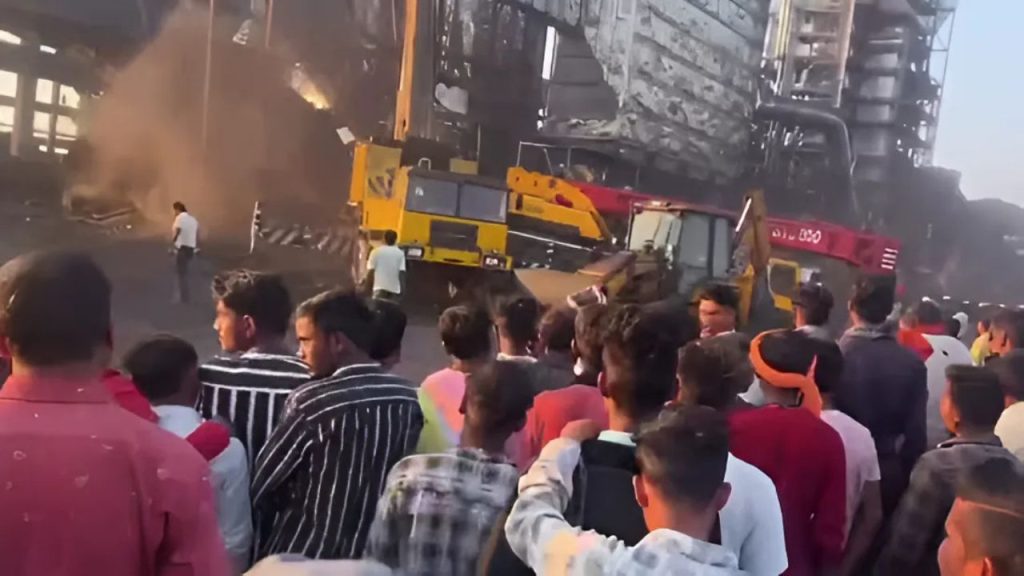
In a tragic incident in Chhattisgarh, a steel plant in Mungeli witnessed the collapse of one of its chimneys, leading to a significant loss of life and causing a major crisis for the plant and surrounding community. According to reports, the catastrophic collapse resulted in one fatality, with two others still missing, sparking fears of further casualties and creating an atmosphere of panic and confusion. This incident has drawn attention not only to the safety practices at industrial plants but also to the challenges of responding to emergencies in such dangerous environments.
The Incident: A Fatal Collapse
The steel plant in Mungeli, located in the central part of Chhattisgarh, was operating when the chimney, a large structure used for releasing exhaust gases from the plant’s furnaces, suddenly collapsed. It’s believed that the collapse occurred without much warning, sending a cloud of dust and debris into the air. Workers and bystanders in the vicinity were immediately affected, with some caught under the rubble of the falling chimney.
Rescue operations were launched quickly after the collapse, with local authorities, fire department personnel, and workers from the plant coming together to search for survivors and recover bodies from the debris. Unfortunately, despite their best efforts, the death toll stood at one confirmed fatality, and two others remain missing. These individuals are presumed to be either trapped under the rubble or lost in the debris, though their exact whereabouts are yet to be determined.
The collapse of the chimney, which was a large and towering structure, raised questions about the structural integrity of such facilities and whether the plant had followed the necessary safety regulations and preventive measures.
Impact on Workers and the Community
The immediate aftermath of the chimney collapse has left the workers at the steel plant and their families in a state of shock and distress. As rescue teams scoured the debris in search of the missing, the families of the workers anxiously waited for any updates on the whereabouts of their loved ones. The fatality of one worker has cast a long shadow over the plant, and the disappearance of two others adds to the anxiety. These workers, most of whom had been employed in the steel plant for many years, had families and obligations, and their sudden disappearance has caused deep emotional pain.
For the local community, the incident is a painful reminder of the inherent risks associated with industrial plants and heavy manufacturing. Mungeli, being a relatively small town, is home to several such industrial facilities. The collapse of the steel plant chimney has raised concerns not only about the safety of workers but also about the environmental consequences of such accidents. The surrounding area, which is home to many residents, could also be impacted by falling debris, toxic gases, and other hazardous materials that may have been released during the incident.
The environmental and social ramifications of the collapse are significant. Beyond the immediate loss of life, the people of Mungeli will be left grappling with the aftermath, dealing with both the emotional and physical consequences of such a devastating event. Local authorities are likely to face criticism over their ability to enforce stringent safety regulations at industrial sites, and the community will undoubtedly demand changes to ensure that such an incident never happens again.
Industrial Safety and Structural Concerns
The incident has highlighted an ongoing issue within the industrial sector in India: the concern for industrial safety and adherence to regulations. Steel plants, cement factories, and other heavy manufacturing facilities often operate in hazardous conditions, and accidents like this are not entirely uncommon. The collapse of a chimney is not just an isolated incident—it raises serious questions about the safety standards, maintenance procedures, and regulatory oversight governing such industries.
Structural integrity is a key issue in cases like this. Chimneys and other tall structures in industrial plants are subject to extreme heat, pressure, and wear over time. If they are not regularly inspected, maintained, and repaired, they may become vulnerable to failure. Moreover, the materials used in construction must meet strict quality standards, and engineers must ensure that the structures are designed to withstand the stresses placed upon them. Failure to adhere to these principles can lead to deadly consequences, as was seen in Mungeli.
Another critical factor is the maintenance of industrial equipment and safety systems. Steel plants often deal with high temperatures, molten metal, and various hazardous chemicals. Workers must be equipped with the right safety gear, and plants must have emergency protocols in place to handle accidents. Proper training in handling equipment, responding to fires, and evacuating personnel are necessary for preventing fatalities and reducing risks. The Mungeli tragedy raises questions about whether safety measures were followed and whether workers were adequately trained to deal with emergencies.
Rescue Operations and Government Response
Following the collapse, local rescue teams were quick to respond to the scene. Firefighters, emergency medical teams, and workers from the steel plant joined forces to conduct search and rescue operations. These teams worked tirelessly for hours, often under difficult and hazardous conditions, to locate the missing individuals and recover the body of the deceased. The rescue operations were complicated by the sheer scale of the damage, as the collapsing chimney was massive and left behind a pile of rubble that was challenging to navigate.
The local government, including the District Collector’s office, provided support for the rescue efforts and has promised further assistance to the families of the deceased and missing. Relief efforts are also underway to provide financial support to the affected families. The Chief Minister of Chhattisgarh has expressed his condolences and directed local authorities to investigate the cause of the accident thoroughly.
A team of experts has been dispatched to the steel plant to inspect the collapsed chimney and assess the situation. The investigation will focus on determining whether negligence or faulty construction practices played a role in the collapse. The findings of the inquiry are expected to lead to improvements in safety standards, not just in Mungeli, but across the state, to prevent similar accidents in the future.
Long-Term Consequences and Calls for Reform
The collapse of the steel plant chimney in Mungeli is a stark reminder of the dangers faced by workers in high-risk industries. Beyond the immediate loss of life, the incident has raised broader questions about industrial safety in India. As the country continues to industrialize, it is crucial that safety standards and regulatory frameworks are strengthened. This includes better oversight, more frequent inspections, and tougher penalties for companies that fail to comply with safety regulations.
The Chhattisgarh government is likely to face increased pressure to enforce stricter safety laws and to improve infrastructure for handling such emergencies. While immediate efforts are focused on recovering the missing individuals and providing support to the affected families, the long-term consequences of this tragedy will likely prompt calls for reform within the industrial sector.
At the same time, this incident serves as a cautionary tale for other industrial plants in the region. It is a reminder that industrial growth should be matched with careful attention to safety, maintenance, and risk management to ensure that the lives of workers are not put at unnecessary risk.
Conclusion
The collapse of the steel plant chimney in Mungeli has left the community reeling from a tragedy that claimed one life and left two others missing. This event not only highlights the immediate dangers faced by workers in hazardous industries but also exposes larger issues related to industrial safety, regulation, and emergency response. As rescue operations continue and investigations are launched, it is clear that this incident will have far-reaching consequences for both the industrial sector and the local community. Ultimately, the tragedy serves as a reminder of the need for stringent safety protocols and the continued vigilance required to protect workers and the public in high-risk industrial environments.
